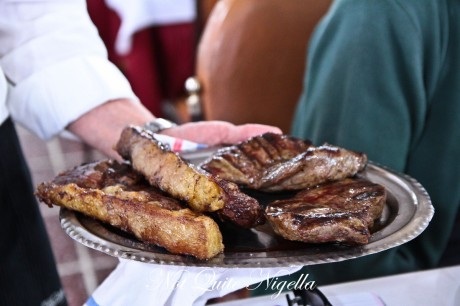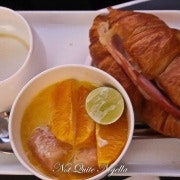Crime and nourishment in Argentina
Australia's favourite food blogger, Not Quite Nigella, aka Lorraine Elliott, gets a lesson in the DOs and DON'Ts of Argenitinian dining and explores the history of one of the country's great presidents.
The quickest way to peg yourself as a tourist is to do things that locals wouldn’t be caught doing in their right mind. And nowhere is this more obvious than when you’re sitting face to face with someone enjoying a meal.
Here is a list of food related crimes in Argentina according to our Argentinian guides Luciano and Francisco from Cultura Cercana. Not punishable by law but perhaps by social ostracism:
– It is a crime to mix mozzarella with provoleta (the cheese that we had yesterday).
– It is a crime to use gas on your parilla (grill). Coals (carbon) or wood is the only thing you should use.
– It is a crime not to share your yerba tea or to touch or play with the straw.
– It is a crime to serve your meat with sauce. Salt is the only thing that should garnish steak.
– It is considered disrespectful for anyone but a close friend at a home gathering to insult or comment on the cooking method of a parilla chef – You must also clap for the parilla chef.
The drive to Los Platitos from the Sofitel in the upmarket Recoleta district is punctuated on the right by parilla stands (pronounced as pa-risha, the sound turns to a shh but only in Argentina). The River de la Plata meaning silver river sits just past this and the water is an uninviting brown due to the sediment. Fishermen line the way with their fishing rods and incongruously, to the left is a plane taxiing down a runway and a train speeds by in the distance. Families unpack picnic baskets and sit alongside the domestic airport and eat lunch while watching the planes take off the distinct rumbling a comforting soundtrack to many families that live in Buenos Aires.
I’ve lucked out with my taxi driver. Not only is he friendly but he points out several items of interest along the way. I arrive at Los Platitos (about 20 minutes away) or about 75 Argentine pesos ($A14.50). Facing the river, it is a local’s favourite where couples sit by the counter watching the parilla masters cook their grass fed steaks to perfection while families and larger groups take up space in the main restaurant area. Fat sausages cook on the grill and steaks of every cut are cooked slowly and simply with just salt as a garnish.
At the restaurant I meet the rest of our travel writer’s group and our two guides for the day, fifth generation Argentinian Luciano and Francisco. Luciano’s company La Cultura Cercana, holds tours for English speakers and for lunch he has taken us to his favourite local place “This is a place where only locals would go, not tourists.” Someone in the group notices a distinct lack of female waitresses. “Perhaps it sounds strange but to local, a woman bringing a big piece of meat would be strange,” Luciano explains, which raises some eyebrows among our female only group.
We start with provoleta, a cheese that comes as a disc and is grilled on the parilla. It is soft on the inside and somewhat like a halloumi without the squeak – a tasty cheese melted.
Francisco and Luciano explain that as the steak is cooked slowly to keep it tender, side dishes like the provoleta, salad and hand cut chips are brought out. The hand cut chips are hot to the touch and we salt these crunchy batons eagerly all while puffing on each bite.
The salad is like one of those you used to see in Australia during the 70s – Iceberg lettuce, tomato and onion, needed because the steak is rich.

Bife de chorizo 95 Argentine pesos ($A21) and bife de lomo 110 Argentine pesos ($A24.33)
The beef comes out after resting time. We have two cuts of beef: the bife de chorizo or sirloin, which is slow cooked and comes ringed with fat for extra flavour; and the bife de lomo or the tenderloin. The bife de chorizo, not to be confused with the Spanish sausage chorizo, is so named apparently because it resembles a chorizo sausage when it is removed. The two cuts taste quite different, the sirloin having more flavour from that ring of fat, while the tenderloin, as the name suggests has a milder flavour but a superb tenderness.

Panqueque de dulce leche $28 Argentine pesos ($A6.19)
Dulce de leche (pronounced dool-say deh leh-chay) which literally means 'sweet of milk' is the favourite spread and this condensed milk caramel comes in a range of brands. The best we are told is “Poncho Negro” which is the creme de la creme of dulce de leche and La Serenisima is a regular supermarket brand that is said to be very good too, according to Luciano and Francisco. Here it is served on a yellow pancake, slightly thick and spongey, which soaks up the sweet and oozing dulce de leche caramel nicely. And every intention to eat just one bite should come with a warning: it is virtually impossible to do!
Our next stop is the garden of roses in Parque Tres de Febrero (February Three Park). It is apparent that some people like it very, very much as couples every which way are locked in passionate embraces.
Our last stop that afternoon is the La Recoleta cemetery, famous for the presence of Evita Peron’s body...
Click here to read the full post...
















